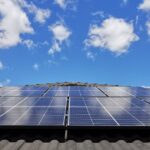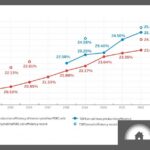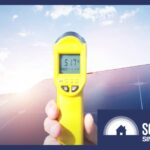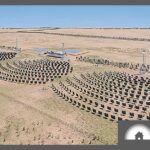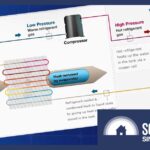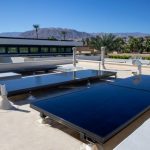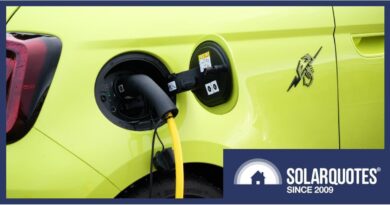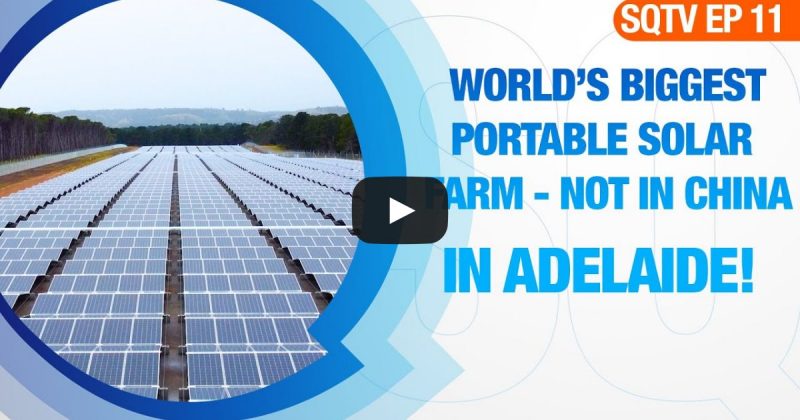Maximising Solar Efficiency in Heat Waves: An Aussie Guide
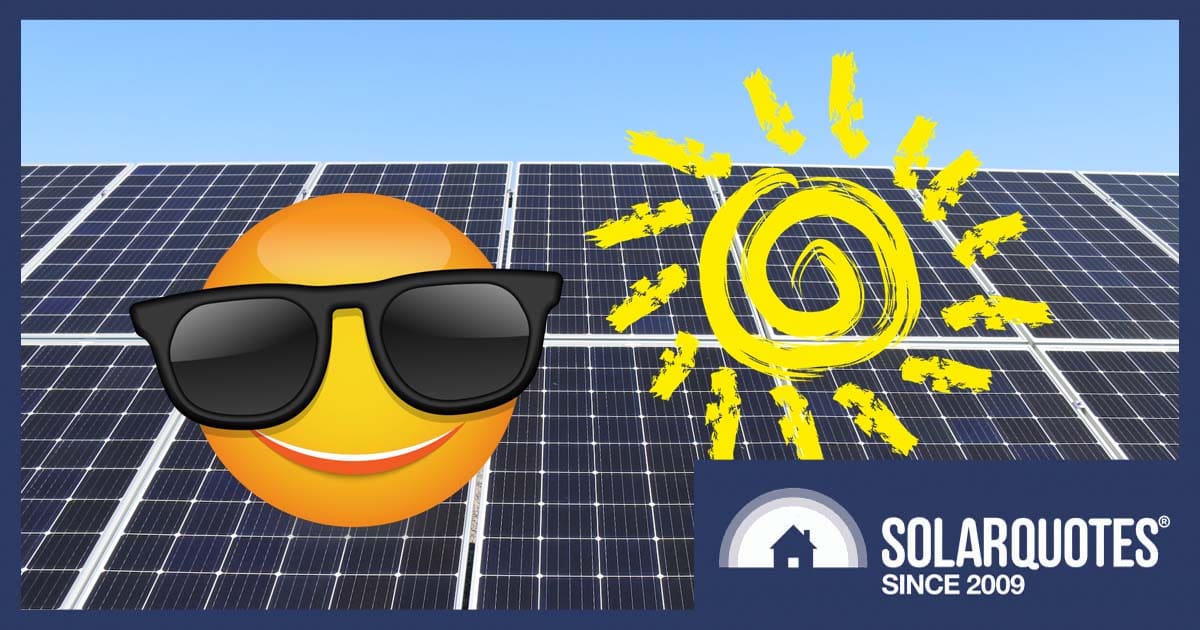
With another scorching summer looming on the horizon, spare a thought for the solar panels doing it tough up there on the roof. There’s a common misconception that PV rooftop solar thrives in the heat just like a thermal solar system, but in fact, the opposite is true.
In this guide, we’ll look at the essential design and buying tips for ensuring your solar system not only endures but excels at maximizing your energy harvest during the scorching Australian heat waves.
What’s The Big Deal With Heat And Solar?
Photovoltaic (PV) solar panels convert sunlight into electricity, but their efficiency declines as temperatures rise. Unlike solar thermal hot water panels, solar PV benefits from cooler conditions, making good design a consideration for mitigating the effects of heat on energy production.
Each degree of temperature above 25ºC reduces the efficiency of a solar panel. That’s the panel’s temperature, not the air. The amount by which it is reduced is called the temperature coefficient (Pmax) and is measured at NOCT (Nominal Operating Cell Temperature), which, among other things, specifies an air temperature of 20ºC when tested in the lab.
Considering the average NOCT is about 45ºC, it’s fair to say that, in the real world, any day when the air temperature reaches above 20ºC, a solar panel’s efficiency will be negatively impacted by heat. That impact may not be much on a mild day, but add a few degrees, and the picture changes.
Using data from BOM (Bureau of Meteorology) for the location of Perth over the last 12 months, 80% of days had a maximum temperature above 20 degrees. Over 25% of days had a max of more than 30 degrees, which I’m sure you’ll agree didn’t do any favours for temperature-related efficiency loss.
But wait, there’s more. In the solar world, all days aren’t equal. Typically, the days with high temperatures also have more peak sun hours. So potentially, most of a rooftop solar’s energy harvest is during the hottest periods.
Re-calibrating to take sun hours into account, over 85% of sun hours occurred on days when the temperature reached above 20 degrees. More than 34% of sun hours occurred on days when the temperature soared past 30 degrees.
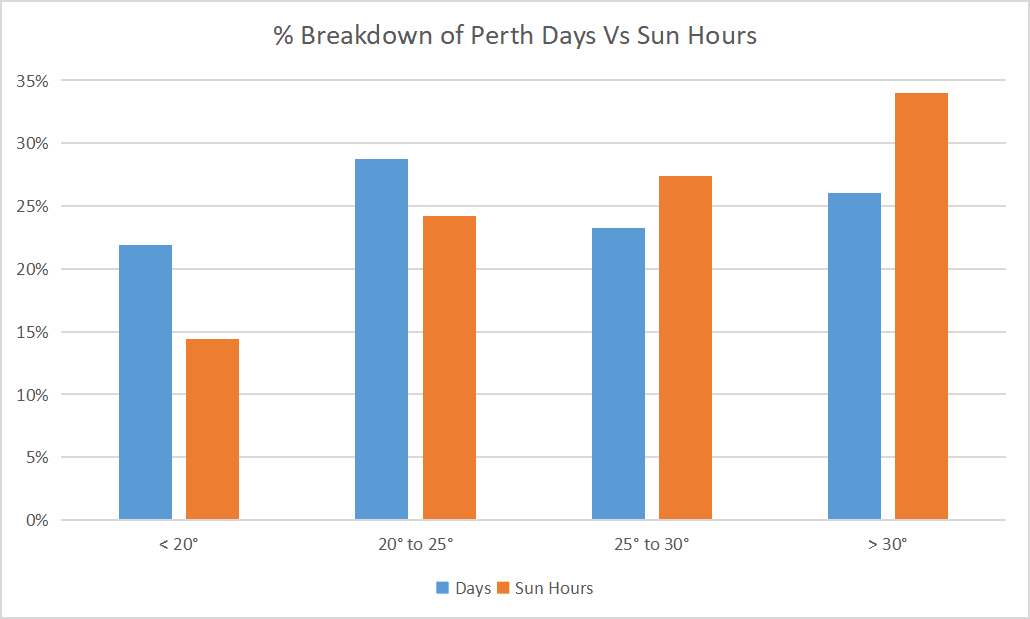
Percentage breakdown of Perth days vs sun hours over the last 12 months, showing the days with higher temperatures also having more sun hours, and so having a greater impact on temperature-related efficiency loss.
Is Temperature Coefficient Relevant?
If you’re the sort of person who enjoys self-torture by numeric equations and would like to know how the temperature coefficient works from a mathematical perspective, I recommend reading this article.
For the rest of us, if you’re considering investing in solar energy, it might be worth looking at a solar panel that performs well in the heat. Eyeballing the datasheet, the temperature coefficient (Pmax) should have a negative number that is as close to zero as possible. For example -0.37%/°C is better than -0.40%/°C.
When comparing the best and worst performing (temperature-wise) panels, there’s only a difference of 0.31% for each 1°C increase in cell temperature over 25°C (best -0.21%/°C vs worst -0.52%/°C). This amounts to a worst-case (between best and worst) of about 3% efficiency loss on a 30° day and 6% on a 40° scorcher1.
Also, the loss isn’t across the whole day because it’s a dynamic number that varies as the temperature changes; therefore, in practice, it’s impossible to quantify the energy/ dollars saved from one solar panel to the next with regard to temperature-related efficiency loss.
So, is the temperature coefficient worth worrying about? Some people don’t think so, and maybe they’re right. But bear in mind a panel with a low-temperature coefficient is likely to score high in other specifications as well.
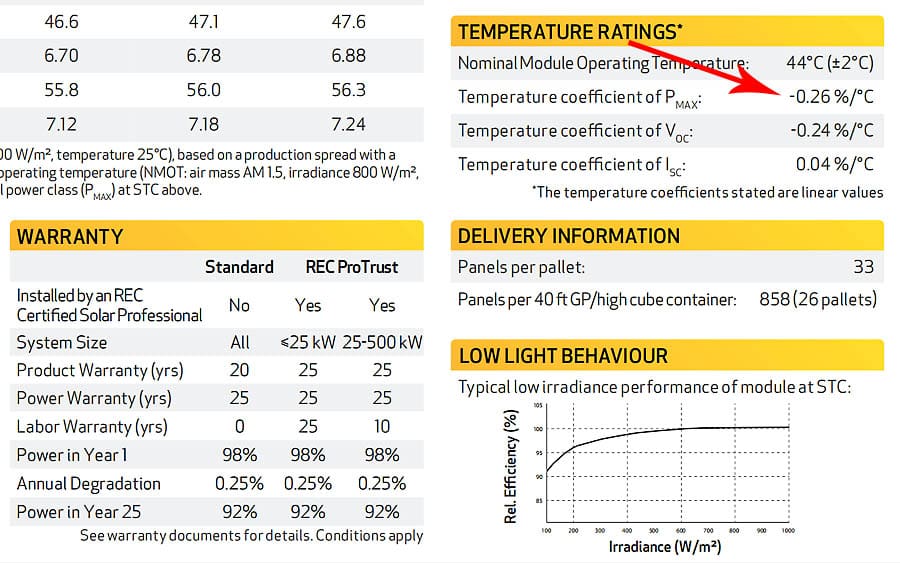
REC Alpha Pure R Series datasheet shows a very good temperature coefficient (Pmax) of -0.26%/°C
Air Conditioning And Solar
As we plough through from one heatwave to the next, you’re quite rightly worried about the escalating cost of running your air conditioner. It makes sense to get the sizing and design aspects of a new rooftop solar system just right to help minimize those costs.
First Things First
I can’t stress strongly enough that getting the insulation of your building envelope right before you think about solar is always the best and most economical approach. The only free energy is the energy you don’t use, so at a minimum, ensure your roof insulation is adequate and address all air gaps in doorways and windows. Preferably, have a professional energy audit and jump on the MEEH Facebook page for free advice from a switched-on community.
Assuming you have your insulation sorted, our next assumption is that you’d like your new rooftop solar system to cover energy costs for a medium-sized air conditioner running during the hottest hours of the day on the hottest months of the year. We’ll deal with winter another time.
Sizing Solar For Air Conditioner Load
Here is a simple 4-step method for sizing a grid-connected rooftop solar system to meet the load of your air conditioner. This method may not be suitable if you have other priorities or for an off-grid system. Also, it is to be used in conjunction with advice from your installer.
1. Determine Air Conditioner Power:
This involves some guesswork for cycling electrical appliances like air conditioning and fridges. Unlike designing for off-grid solar, where the full power rating is important, we’re mainly interested in the average power for grid-connected purposes. It is sometimes written on the datasheet, but not always. This example will use a 7 kW (output) split system air conditioner with a peak load of 2.5 kW. Using some black magic, we’ll assume an average of 2 kW running load.
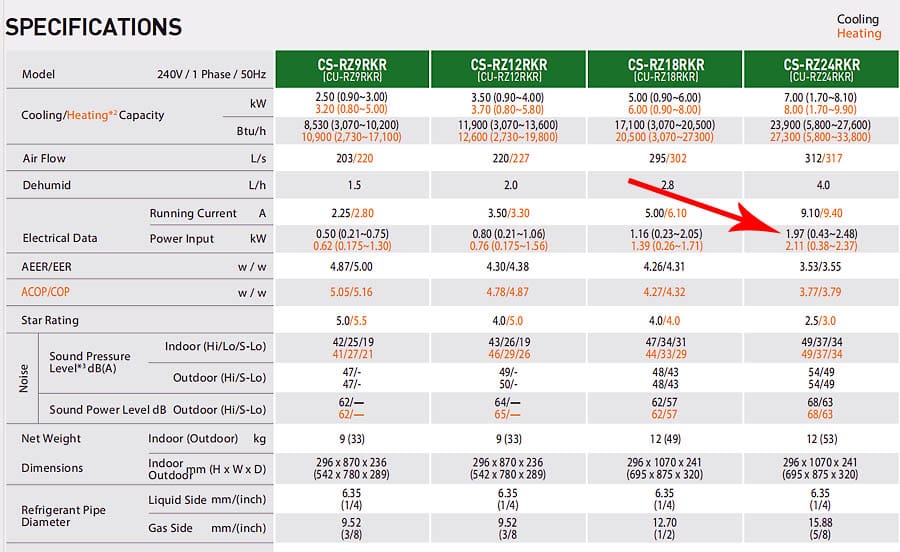
Panasonic CS Series data sheet showing a 7 kW (output) split system air conditioner with cooling power input (marked by a red arrow) 1.97 kW (average) 0.43 kW (low) ~ 2.48 kW (high).
2. Calculate Daily Energy Consumption:
To calculate the daily energy consumption during heatwave conditions, simply multiply the average power (above) by the expected running hours on your hottest day.
2 kW (average power) x 16 hours (daily run-time) = 32 kWh (daily energy consumption)
3. Ascertain Energy Requirements For Hottest Month:
More assumptions: You’re living in Perth, where each kW (kilowatt) of rooftop solar installed produces an average of approximately 4.4 kWh (kilowatt-hours) daily energy. However, for this calculation, we’re only interested in your energy requirements during heatwave conditions, so you need to know the daily kWh energy production per installed kW of solar in the hottest month for your location.
The easiest way to find that out is to go to the PVWatts website and enter your details. There’s a great explainer here. The example I’m using is for Perth in the month of February. I should have 5.8 kW per day energy production per kilowatt of solar installed.
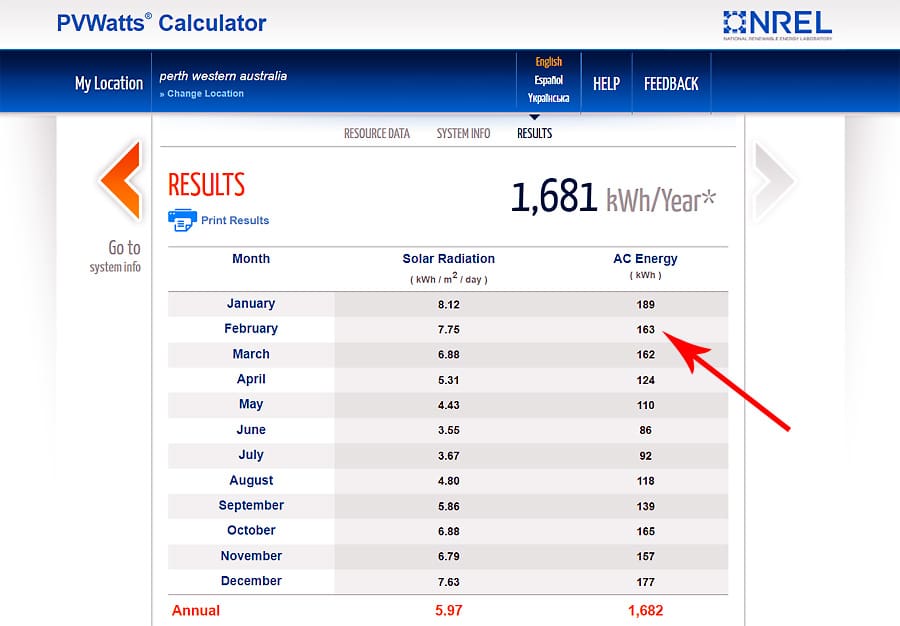
The example here shows 163 kWh solar production per kW in the month of February. Divide this by the number of days in the month (5.8 kWh per day)
4. Calculate Required Solar Panel Capacity:
Divide your air conditioner’s daily energy consumption by solar daily energy per kilowatt of solar production.
32 kW (daily energy consumption) / 5.8 kWh (daily kWh per kW solar production) = 5.5 kW (rooftop solar capacity needed)
Things To Note:
The above doesn’t take into account any other household loads. It’s simply a way to determine solar energy requirements to cover air conditioner use during a grid-connected system’s hottest time of year. There are many other considerations when designing a household rooftop solar system.
Solar Panel Orientation
As we’re talking about heatwave conditions, it would make sense to point your solar panels in the sun’s direction during the hottest time of the day to take advantage of solar self-consumption when the air conditioner is working hardest. That would be pretty much bang on north-west (azimuth 315°) at around 2 pm in Perth during February.
A westerly orientation of some degree would probably align with other household peak loads as well. Back in the land of reality, most of us are stuck with the roof we have, so do the best you can with what you’ve got, and don’t lose any sleep over it.
Solar Loves A Cool Breeze
Like we do, our solar panels don’t mind a cool breeze on a hot summer day. Studies have confirmed that wind reduces the PV cell temperature and improves the electrical output of solar panels. It’s desirable to have that cool breeze roll in before 2 pm, preferably from the direction your solar panels face.
Here in Perth, we’re lucky in that regard. If you live within 5 or 10 km of the coast, the southwest sea breeze predictably starts blowing from about midday on most summer days except for the real scorchers above 30+ degrees. That wind direction coincidentally gives a helping hand to any solar panels having a westerly orientation.
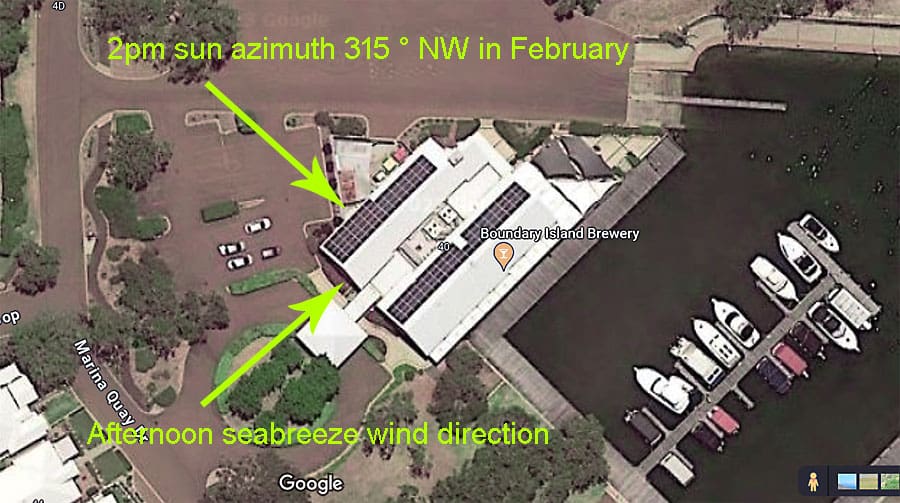
This impressive 50 kW rooftop solar system at one of my local breweries is oriented perfectly to reach peak power production mid-afternoon and take advantage of the prevailing sea breeze. Plus, they have fantastic food and a wide selection of boutique beers to cool off with.
What About The Inverter?
Yes, inverters like cool breezes too. Any hardware containing power electronics should be well-ventilated. Inverters produce heat as a normal part of their operation and need space for heat dissipation.
Solar inverters are designed to operate within a specific temperature range. When the ambient temperature exceeds this range, the inverter will stop or reduce the power it generates by ‘derating’ as it passes programmed temperature thresholds. For you, that’s like throwing money out the window.
Passive Vs Active Cooling
Passive cooling is a method that uses cooling fins to increase its surface area to lower the components’ temperature through convection. On the other hand, active cooling uses external methods such as fans to remove excess heat.
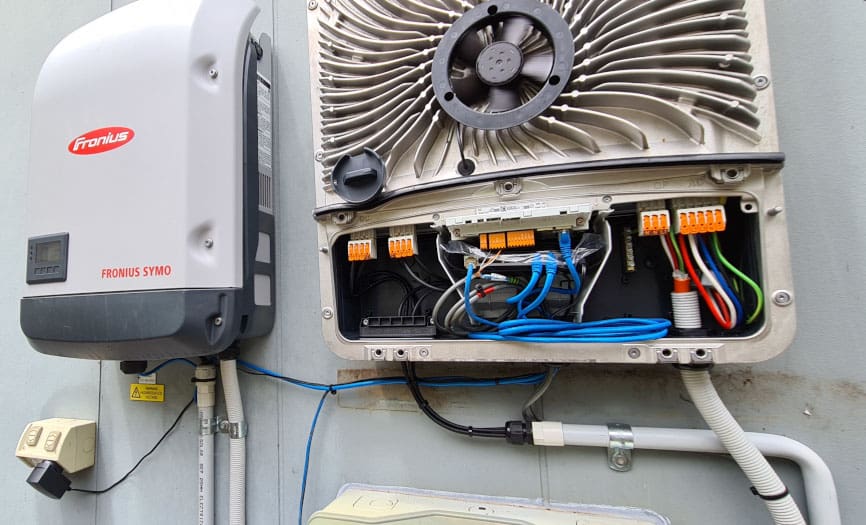
The active cooling on the Fronius GEN24 inverter is genius, with the cooling fan blowing directly on to a cleverly designed heatsink. Image: Solar Depot
For inverters living in a hot climate, I’m putting my money fairly and squarely on active cooling as the winner. It’s not just the derating factor to worry about but also the shortened lifespan, as components deteriorate due to higher temperatures over time.
Three golden rules for a happy inverter on a hot day:
- Keep it shaded.
- Keep it ventilated.
- Keep it clean!
Many solar owners have installed their own shade covers and even rigged up external fans blowing on their inverters to keep cool when needed. For these DIY approaches, I say go for it. Any way to stay cool on a hot day is a good thing.
Smart Choices To Beat The Heat
By understanding the nuances of temperature coefficients, sizing your system for air conditioner loads, and considering factors like panel orientation and inverter cooling, you can ensure your solar investment weathers the heat waves as well as you do. Choose panels wisely, embrace the sea breeze, and give your inverter the TLC it needs. Stay cool.
Footnotes
- These figures are taken from an outdated chart, and today’s specifications would most likely be much closer between best/worst performers ↩
Original Source: https://www.solarquotes.com.au/blog/heatwave-resilient-solar/



